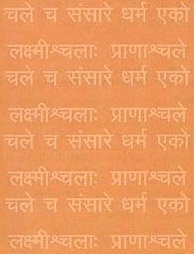Neutrality: 1 definition
Introduction:
Neutrality means something in Hinduism, Sanskrit. If you want to know the exact meaning, history, etymology or English translation of this term then check out the descriptions on this page. Add your comment or reference to a book if you want to contribute to this summary article.
In Hinduism
Samkhya (school of philosophy)
Source: ORA: Amanaska (king of all yogas): (samkhya philosophy)(The state of) Neutrality is denoted by the Sanskrit term Mādhyasthya, according to the Mādhyasthya.—In Brahmanical literature, udāsīna often means a neutral person, such as in the compound; “friends, neutrals and enemies”. [...] Also, udāsīna has been used in the Sāṅkhyakārikā to qualify the individual soul. After describing the qualities of the Puruṣa as the state of witnessing, isolation, neutrality (mādhyasthya), awareness and non-agency in Kārikā 19, the Sāṅkhyakārikā (20) then qualifies Puruṣa as udāsīna.

Samkhya (सांख्य, Sāṃkhya) is a dualistic school of Hindu philosophy (astika) and is closeley related to the Yoga school. Samkhya philosophy accepts three pramanas (‘proofs’) only as valid means of gaining knowledge. Another important concept is their theory of evolution, revolving around prakriti (matter) and purusha (consciousness).
See also (Relevant definitions)
Full-text (+20): Tatasthya, Tirihaitapana, Madhyasthya, Upekkha, Madhyastha, Upekha, Dvaidhya, Upekkhana, Nishpaksha, Tatasthta, Nishpaksh, Duhkhin, Duhkha, Ubhaya, Traigunya, Tripyat, Ubhayarahita, Shantarasa, Vipaksha, Shamya.
Relevant text
Search found 51 books and stories containing Neutrality; (plurals include: Neutralities). You can also click to the full overview containing English textual excerpts. Below are direct links for the most relevant articles:
'Neutrality' in Ancient India < [July-August 1933]
Lumley in John Wain’s “Hurry on < [July – September, 1989]
International Affairs: A Survey < [July 1970]
Visuddhimagga (the pah of purification) (by Ñāṇamoli Bhikkhu)
The Third Jhāna < [Chapter IV - The Earth Kasiṇa (Pathavī-kasiṇa-niddesa)]
The Fourth Jhāna < [Chapter IV - The Earth Kasiṇa (Pathavī-kasiṇa-niddesa)]
The Ten Imperfections of Insight < [Chapter XX - Purification by Knowledge and Vision of the Path and the Not-path]
Manusmriti with the Commentary of Medhatithi (by Ganganatha Jha)
Verse 4.257 < [Section XXI - End of the Householding Stage]
Kautilya Arthashastra (by R. Shamasastry)
Chapter 4 - Neutrality after Proclaiming War or after Concluding a Treaty of Peace < [Book 7 - The End of the Six-fold Policy]
Chapter 1 - The Six-fold Policy < [Book 7 - The End of the Six-fold Policy]
Chapter 2 - The Nature of Alliance < [Book 7 - The End of the Six-fold Policy]
The Tattvasangraha [with commentary] (by Ganganatha Jha)
Verse 1779 < [Chapter 20 - Examination of Syādvāda (doctrine)]
The Buddhist Path to Enlightenment (study) (by Dr Kala Acharya)
1.7. Enlightenment Factor of Equanimity < [Chapter 3 - Seven Factors of Enlightenment and Noble Eightfold Path]
1.3.2. Vedanānupassanā–Contemplation of the Feeling < [Chapter 2 - Five Groups of Factor]